
The Thuringian Forest, is a mountain range in the southern parts of the German state of Thuringia, running northwest to southeast between the valley of the river Werra near Eisenach and the Thuringian-Vogtlandian Slate Mountains. The geographical boundary with the latter range follows approximately a line from Gehren via Großbreitenbach to Schönbrunn near Schleusingen, defined by the rivers Schleuse and Neubrunn on the southwestern slope, and Talwasser, Wohlrose and Möhre on the northeastern slope.
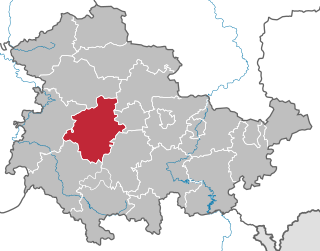
Gotha is a Kreis (district) in western central Thuringia, Germany. Neighboring districts are Unstrut-Hainich-Kreis, Sömmerda, the Kreis-free city Erfurt, Ilm-Kreis, Schmalkalden-Meiningen and the Wartburgkreis.

Saale-Orla is a Kreis (district) in the east of Thuringia, Germany. Neighboring districts are the districts Saale-Holzland, Greiz, the Vogtlandkreis in Saxony, the Bavarian districts Hof and Kronach, and the district Saalfeld-Rudolstadt.
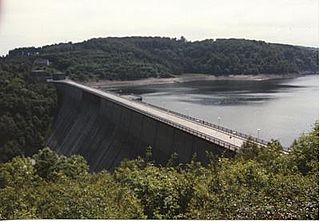
The Rappbode Dam is the largest dam in the Harz region as well as the highest dam in Germany. Together with several other dams and retention basins, it forms the flood protection system for the eastern Harz.
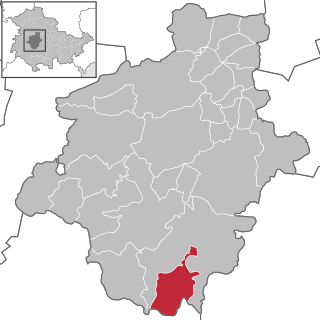
Luisenthal is a municipality in the district of Gotha, in Thuringia, Germany.
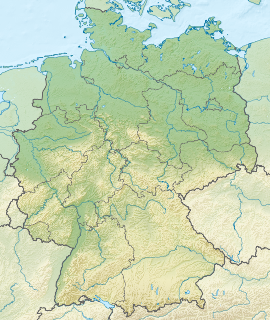
The Söse Dam is a dam in the Lower Saxon part of the Harz mountains near Osterode in the German state of Lower Saxony.

The Neustadt Dam, also known as the Nordhausen Dam is the oldest dam in the Free State of Thuringia in Germany. It supplies drinking water to the town of Nordhausen. The dam is a curved gravity dam made of rubble stone based on the Intze Principle. The dam was built in 1904–1905 in the southern Harz mountains and raised by a further 6.26 metres in 1922–1923. The impounded stream is the Krebsbach. The operator of the dam is the Thüringer Fernwasserversorgung; the water is supplied to the Wasserverband Nordhausen.

The Königshütte Dam is a dam in the German state of Saxony-Anhalt in the Harz mountains. It impounds the River Bode and lies between Königshütte and Susenburg. It is a so-called storage reservoir (Überleitungssperre) forming part of the Rappbode Dam system.

The Wendefurth Dam near Wendefurth in the Harz is one of the dams downstream of the Rappbode Dam, that provides flood protection as well as impounding the River Bode to provide the lower reservoir for the Wendefurth Power Station. In addition it is a bathing lake and also supports fish farming.
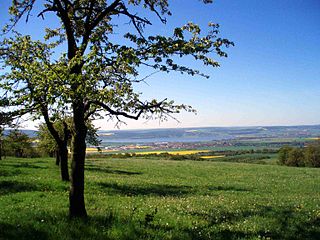
The Kelbra Dam is a dam on the River Helme in the German state of Saxony-Anhalt. Behind the dam is the lake known as the Kelbra Reservoir or Kelbra Flood Retention Basin.

The Saidenbach Dam is a dam in the German state of Saxony. Its reservoir supplies drinking water to Chemnitz and, in conjunction with the Central Ore Mountain Dam System and its other dams - Neunzehnhain I und II and Einsiedel - contributes to the supply of the region covered by the South Saxony Long Distance Water Association.

Cranzahl Dam is a dam in the Free State of Saxony in East Germany. It was built from 1949 to 1952 near Sehmatal–Cranzahl and the Bärenstein mountain in the Ore Mountains to supply drinking water to Annaberg-Buchholz and the surrounding area. Together with the Sosa Dam it was one of the two biggest dam construction projects of the newly created GDR. In keeping with the time it was called the Dam of Friendship.

Eibenstock Dam near Eibenstock in the Ore Mountains, Germany, is the largest dam in the Free State of Saxony in terms of the height of the dam above the valley floor, and its reservoir is the largest in volume in Saxony. The dam impounds the waters of the Zwickauer Mulde and supplies drinking water to the region of Chemnitz and Zwickau, as well as providing flood protection, delivering extra water during times of drought and, to a lesser extent, generating electricity from hydropower. Its dimensions make it the second largest drinking water reservoir in Germany's new federal states.
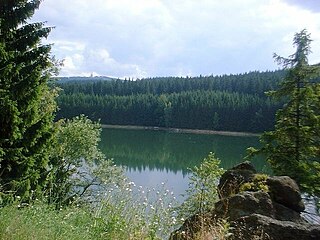
The Sosa Dam is a dam in the Free State of Saxony in East Germany. It supplies drinking water to the Western Ore Mountains as well as acting as flood protection.
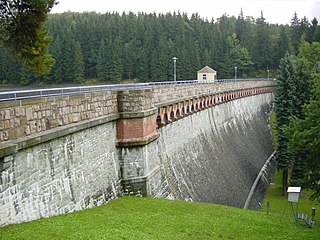
Einsiedel Dam is located in the German Free State of Saxony. Its reservoir supplies drinking water to Chemnitz and, in conjunction with the Central Ore Mountains reservoir system, that includes the reservoirs of Neunzehnhain I, II and Saidenbach also supplies water to the entire region covered by the South Saxony Long Distance Water Association.

The Leibis-Lichte Dam is a 102.5-metre-tall (336 ft) dam in the German state of Thuringia in the Thuringian Highland. The dam was completed in 2005 to impound the River Lichte, between the Lichte municipality section Geiersthal and Unterweissbach. To that particular storage reservoir belongs the Deesbach Forebay. The name of the dam, "Leibis-Lichte Dam" was derived from the close proximity to the municipalities of Leibis and Lichte, as well as from the Lichte River as being the main inlet.

The Deesbach Forebay is a dam in the German state of Thuringia in the Thuringian Highland. It impounds the river Lichte and lies between the municipalities Lichte (Geiersthal) and Unterweissbach. That particular forebay belongs to the Leibis-Lichte Dam.
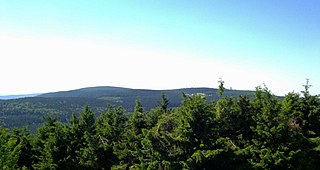
The Thuringian Forest Nature Park is one of the two nature parks in the state of Thuringia, Germany.
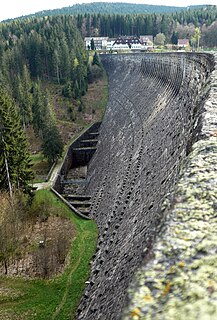
The Schwarzenbach Dam is a gravity dam near Forbach in the Northern Black Forest of Germany. It is the most important structure of the Rudolf-Fettweis-Werk's pumped storage power station. The operator of the dam, which was completed in 1926 in a side valley of the Murg valley, is EnBW Kraftwerke.
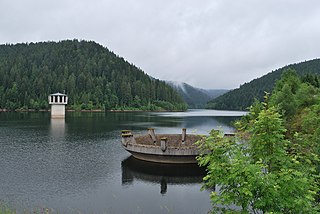
The Kleine Kinzig Dam is a dam which was commissioned in 1984 in Reinerzau near Freudenstadt in Germany's Black Forest. It lies within the state of Baden-Württemberg and supplies drinking water, provides flood protection, drought protection and power generation using hydropower. It impounds the Kleine Kinzig river; the dam belongs to the Kleine Kinzig Special Purpose Association




























